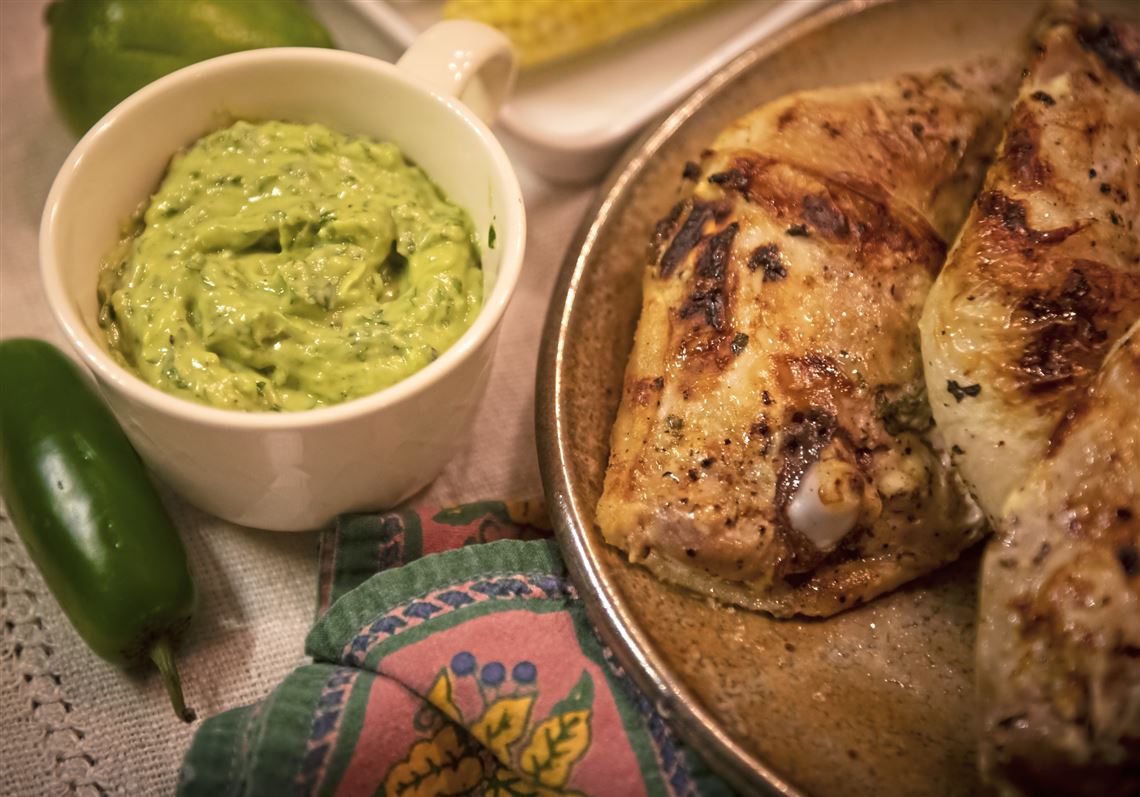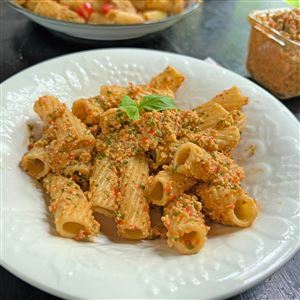There’s something about cooking in your eighth decade when that inner voice whispers, maybe you’ve striven enough. Let someone else learn to bone that chicken and truss it up again, stuffed.
You’ve been hostage to many a “simply do this, merely do that” recipes — the kind that never would say: Active time will be all day and part of tomorrow, not counting two trips to the store.
Take a break from this, the self-talk says. Merely discover an easier way to make an impression.
This summer’s wet start inspired me. June is spewing out fresh green herbs, maybe too many, to markets and home gardens. Piling up will be parsley, cilantro, mint, basil, oregano, tarragon — all shouting to be chopped or whizzed into vivid green sauces, full of bright, lingering, pungent, refreshing flavor.
Their job? To electrify everyday food, from a sheet-pan dinner to a mess of steamed veggies.
Simple to make, versatile in use and complex in flavor, these splashes of green will elevate your already good summer grilling of salmon, drumsticks, flank steak and corn. Streak some of this green through jarred butter beans, cooked lentils, tofu or scrambled eggs. Or dollop a spoonful on lamb chops, roasted cauliflower, tacos, any tomato salad, rice and beans — all are good medicine.
Green sauces are ancient and most have heat from a little (or a lot, your call) green chile or dried red pepper. How much of which herb to use is elastic, too. If cilantro tastes like soap to you, substitute basil, or dill or more parsley. Or all parsley.
If you’re a chopper, chop away. Or hack the greens roughly and let the mortar and pestle grind heavenly color and flavor into the suspending oil. Purists do. When speed’s important, however, a food processor or mini-processor works extremely well.
These four sauces are money in the bank to me:
Guasacaca
Beloved by Venezuelans is guasacaca (pronounced wah-sa-ka-ka). Like many green sauces, this one starts with parsley and cilantro, but has its own twist. Ripe avocado is added to the processor (I use a mini-processor) along with the tangy herb and lime base, making a velvety sauce with loft and cling. It is beautiful, only mildly hot, and a celebration to drag a bite of salmon or chicken through. It will serve you the next day, too, spooned over your breakfast eggs, or almost anything.
French-inspired salsa verde
This salsa verde is sort of Frenchified. It takes its name from a heaping cup of parsley, cilantro (or basil) and chives (or green onion tops), chopped. It is a friend to any grilled vegetable.
Here’s a genius combo: Place sweet mozzarella slices beside slightly bitter, smoky seared radicchio and douse both with the caper-y, lemony salsa verde. For another no-fuss option, pass a bowl of salsa verde along with steamed asparagus, cherry tomatoes and some jammy, hard-boiled eggs.
Zhug
Yemen, too, has a national condiment. It is the totally haunting zhug. Like most herb salsas, zhug tastes bursting-fresh from lots of parsley and cilantro.
But there the similarity ends. This sauce is one of a kind — dizzyingly aromatic with toasted coriander, cumin and cardamom, and hot. You shouldn’t use the 4 serranos listed in the recipe — those are the skinny ones, hotter than jalapeños. In fact, maybe two jalapeños is a good place to start. You can add heat after tasting, but too much can’t be undone.
It is worth toasting the spices. Whether you use a mortar and pestle to pound the spices (and then the greens) is up to you. That’s a slightly sweaty Zen effort, rewarded by heady aromas wafting up, messaging how good the end result is going to be. Otherwise the food processor is at hand. You should grind the toasted spices if you can. (A coffee grinder works well. You can fumigate it by grinding a couple handfuls of rice or barley after the spices.)
Chimichurri
From Argentina, the land of legendary beef, comes chimichurri, an oregano-forward, garlicky green sauce that famously enhances grilled meats, from juicy steak to innards and sausage. Most fresh herb sauces are at their oomphiest when made, then slowly fade. Chimichurri lasts weeks in the fridge, just improving. (It really does.)
Do this with one of these sauces: Set a bowlful on the table with any meal and see who puts green sauce on what.
Guasacaca
PG tested
Yewande Komolafe, a New York Times cooking editor, may be best known for partnering with Michelle Obama on “Waffles + Mochi,” the Netflix children’s cooking show. She’s Nigerian, but her take on Venezuela’s guasacaca is the Miss Congeniality of the sauces tested. She omits the traditional, slightly harsh green bell pepper, making this pale blender sauce extra lush and lovely. Serve it with the world’s easiest chicken, yogurt-brined, below.
1 avocado, pitted and chopped
1 jalapeño, stemmed and chopped
2 tablespoons rice vinegar
Zest and juice of 1 lime
1 garlic clove, peeled
½ cup chopped parsley leaves with tender stems, roughly chopped
½ cup chopped cilantro leaves with tender stems, roughly chopped
Salt and pepper
¼ cup olive oil
In a food processor, mini-processor or blender, combine the avocado, jalapeño, vinegar, lime zest and juice, garlic clove, parsley and cilantro, ½ teaspoon salt, ¼ teaspoon black pepper.
Puree into a coarse mixture. With the machine running, slowly drizzle in the olive oil and 1 tablespoon of room-temperature water. Puree or stir until the sauce is smooth and creamy.
Taste and add additional salt if necessary. The sauce can be made a few hours in advance and refrigerated. It will still be very good over the next few days.
Makes about 1 cup.
Yogurt-Brined Chicken Legs
PG tested
1 cup full-fat yogurt
2 tablespoons kosher salt
5 or 6 whole chicken legs
Whisk together the yogurt, salt and ½ cup water.
Place chicken in a gallon-size resealable bag and pour the yogurt mixture over. Seal, pressing out air, and toss to coat. Chill overnight or all day.
Remove chicken from refrigerator while oven heats. Set oven to 400 degrees. Roast, skin-side up, on a rimmed sheet pan until skin is golden brown and crisp. Rotate pan halfway through. Check at 30 minutes. Remove when an instant-read thermometer reads 160 degrees.
Allow chicken to rest at least 15 minutes (temperature will climb to 165 degrees), then serve.
Serves 4.
— “For the Table: Easy Adaptable, Crowd-Pleasing Recipes” by Anna Stockwell (Harry N. Abrams, April 2022, $35)
Salsa Verde with Charred Radicchio and Mozzarella
PG tested
Chef David Tanis brilliantly pairs his lemony salsa verde with charred radicchio and sweet mozzarella. Be sure to let the cheese come to room temperature.
2 radicchio heads, outer leaves removed
¾ cup olive oil, plus more for drizzling
Kosher salt and black pepper
½ cup flat-leaf parsley, leaves and tender stems, chopped
½ cup cilantro (or basil), leaves and tender stems, chopped
2 tablespoons finely cut chives or scallion tops
1 tablespoon roughly chopped capers
1 teaspoon grated lemon zest, plus 2 tablespoons lemon juice (from 1 lemon)
1 pound fresh mozzarella, at cool room temperature
Heat oven to 475 degrees. Cut radicchio heads in half, from top to bottom. Cut each half into 2 or 3 large wedges.
Drizzle each piece lightly with oil and season with salt and pepper. Lay them on a baking sheet and place on the top oven shelf. Roast until radicchio wedges are somewhat softened and charred at the edges, about 15 minutes. (Alternatively, cook the radicchio under the broiler, on the grill or in batches on the stovetop in a cast-iron pan over high heat.)
As radicchio cooks, put parsley, cilantro, chives, capers and lemon zest into a small bowl. Stir in ¾ cup olive oil (I used ½ cup) and lemon juice. Season with salt and pepper.
Cut the mozzarella crosswise into ¼-inch slices. For each serving, put 2 or 3 slices on one side of the plate. Set 2 wedges of charred radicchio beside the mozzarella. Spoon 2 or 3 tablespoons salsa verde in the middle.
Makes about 1 cup of sauce.
Serves 4-6.
— Adapted from David Tanis, nytimes.com
Zhug
PG tested
This sauce from Yemen is supposed to pack some heat. It calls for 4 serranos, but I would start with two, or even substitute two of the less-hot jalapeños. Toasting and grinding peppercorns, cardamom, coriander and cumin seeds are a must if you can.
The individual steps unlock zhug’s terrific aroma. Grind spices in a coffee grinder, then remove spice dust and perfume by grinding a few handfuls of barley or rice. If you plan to use a mortar and pestle, you’ll have to first chop the green herbs. You can make a splendid zhug with a mortar and pestle if you have the half hour or so. Alternatively, you can strip the process down by using ground spices, and combining the ingredients in a food processor and blending until smooth.
The sauce can be made a day ahead, but withhold the lemon juice until just before you serve. Otherwise the colors will be dull.
2 cardamom pods, seeds removed
1 teaspoon black peppercorns
½ teaspoon cumin seeds
4 serrano chiles, chopped
2 garlic cloves, chopped
½ teaspoon kosher salt, with more needed possibly
1 cup very finely chopped parsley
1 cup very finely chopped cilantro
½ cup olive oil
4 teaspoons fresh lemon juice
Toast cardamom seeds, peppercorns, coriander seeds and cumin seeds in a small, dry skillet over medium-high heat, swirling often, until fragrant, 2-3 minutes. Transfer to a spice mill or mortar and pestle and let cool; finely grind.
Mortar and pestle method: Reserve the lemon juice. With ½ teaspoon of kosher salt, mash chopped chiles and garlic with tines of a fork. Add the mashed salt mixture to the mortar containing the ground spices. Pounding and stirring, begin to work in the chopped parsley, cilantro and oil. The volume will subside slowly but surely. My mortar has only 1-cup capacity but, though the process is messy and slow, the recipe easily fits into it. Add lemon juice just before serving, and stir to combine.
Food processor method: Toast and grind spices. Reserve the lemon juice. Add other ingredients to the processor bowl and blend until fairly smooth. This recipe fits into a mini-processor. Taste for salt. Add lemon juice just before serving, and stir to combine.
Makes about 1 cup.
— Adapted from versions by chefs Gabrielle Hamilton, Ana Sortun and Andy Baraghani.
PG tested
This herbaceous and vinegary sauce from Argentina is famous for cutting the richness of grilled meats, especially beef. What makes it different among green sauces is it uses a ton of dried oregano, rehydrated in red wine vinegar and water. There’s plenty of garlic, some fresh oregano and parsley, and just a little olive oil.
¼ cup dried oregano
1 teaspoon sweet paprika
½ teaspoon red pepper flakes (more or less to taste)
½ teaspoon ground cumin (optional)
½ cup hot water
Kosher salt
¼ cup red wine vinegar
8 garlic cloves
2 tablespoons olive oil, plus more as needed
¼ cup fresh oregano leaves, finely chopped
1 tightly packed cup fresh parsley leaves, finely minced
Ground black pepper
Combine dried oregano, paprika, red pepper flakes and cumin, if using, in a large bowl. Add hot water and a big pinch of salt, and stir with a fork. Add vinegar and stir to combine.
Smash garlic with a pinch of salt in a mortar and pestle to form a rough paste, or do this by chopping the garlic and mashing it with the salt using the tines of a fork. Drizzle a little olive oil over the paste and work it in with the fork. Use about a tablespoon of oil, then scrape the mixture up and transfer it to the bowl with the oregano mixture. Add the remaining olive oil and stir to combine.
Add minced fresh oregano and parsley and stir to combine. But don’t taste yet. Set aside at room temperature for at least 30 minutes, or in the refrigerator overnight, to allow the dried oregano to rehydrate and the flavors and texture to develop. Stir vigorously, then adjust seasoning with salt and fresh black pepper. Chimichurri keeps well in the refrigerator for several weeks.
Makes about 1 cup.
— Adapted from J. Kenji Lopez-Alt
Virginia Phillips is a Mt. Lebanon freelance writer.
First Published: June 16, 2022, 10:00 a.m.
Updated: June 16, 2022, 1:59 p.m.







 RECIPE
RECIPE 














